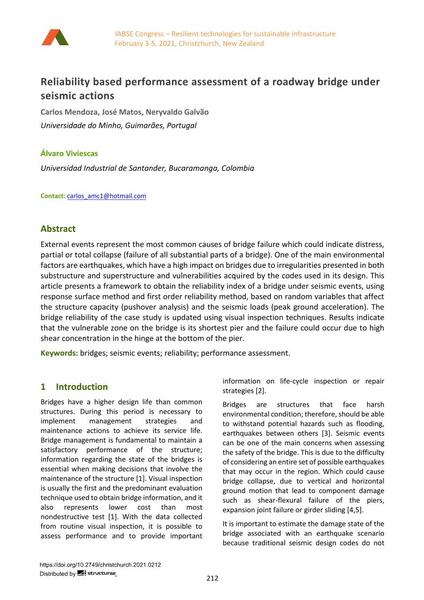Reliability based performance assessment of a roadway bridge under seismic actions

|
|
|||||||||||
Bibliographic Details
| Author(s): |
Carlos Mendoza
(Universidade do Minho, Guimarães, Portugal)
José Matos Neryvaldo Galvão (Universidade do Minho, Guimarães, Portugal) Álvaro Viviescas (Universidad Industrial de Santander, Bucaramanga, Colombia) |
||||
|---|---|---|---|---|---|
| Medium: | conference paper | ||||
| Language(s): | English | ||||
| Conference: | IABSE Congress: Resilient technologies for sustainable infrastructure, Christchurch, New Zealand, 3-5 February 2021 | ||||
| Published in: | IABSE Congress Christchurch 2020 | ||||
|
|||||
| Page(s): | 212-219 | ||||
| Total no. of pages: | 8 | ||||
| DOI: | 10.2749/christchurch.2021.0212 | ||||
| Abstract: |
External events represent the most common causes of bridge failure which could indicate distress, partial or total collapse (failure of all substantial parts of a bridge). One of the main environmental factors are earthquakes, which have a high impact on bridges due to irregularities presented in both substructure and superstructure and vulnerabilities acquired by the codes used in its design. This article presents a framework to obtain the reliability index of a bridge under seismic events, using response surface method and first order reliability method, based on random variables that affect the structure capacity (pushover analysis) and the seismic loads (peak ground acceleration). The bridge reliability of the case study is updated using visual inspection techniques. Results indicate that the vulnerable zone on the bridge is its shortest pier and the failure could occur due to high shear concentration in the hinge at the bottom of the pier. |
||||
| Keywords: |
bridges reliability seismic events performance assessment
|
||||
